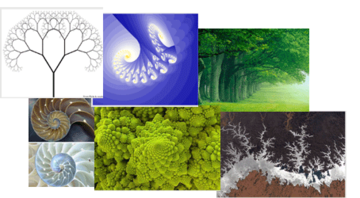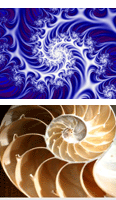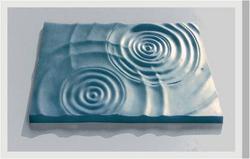WATCH ON YOUTUBE
Leonidas Zoudros
The journey into consciousness and the world of meaning involves identifying patterns of thought and looking deeply into them to understand their hidden relationship to one another and to the causes that lie behind them; and this concept of identifying patterns of relationship is also of great importance in the realm of hard science – physics, chemistry, biology, etc. where patterns in nature and the world around us are searched for and models created to help us understand and explain them.
In this latter case, mathematics is used to construct models with symbols and equations. And the advent of supercomputers that can perform billions of calculations a second has seen tremendous developments in this field through the investigation of complex dynamics. This culminated in the so-called Mandelbrot set in 1980. The Mandelbrot set images are made by feeding complex numbers into a simple equation. Each time a number is fed into the equation, according to a simple rule, the result is either dispensed with or fed back into the equation and repeated. Each of the millions of results of the repeated equation is treated as an image coordinate, and pixels are coloured according to how rapidly the sequence diverges.
The result is this:
The Mandelbrot set is self-similar at each scale of magnification into infinity.
The term which their discoverer, Benoit Mandelbrot, used to describe these equations was “fractal”, from the word fraction. The geometry emerging out of them is known as fractal geometry. Very simply described, a fractal is basically a “rough or fragmented geometric shape that can be split into parts, each of which is often a reduced–size copy of the whole, a property called self–similarity.” As one goes into ever finer resolution of the Mandelbrot picture, self similar, though not exact images, of the whole appear.
Following the example of the Mandelbrot set, it has been discovered that certain types of equations produce results that when laid out visually, bear an uncanny resemblance to forms found in nature.
It demonstrates that the appearance of fractals in nature is an impressive and undisputed fact.
This, in and of itself serves as a first indication of their value as an instrument for research into the realm of spirit and consciousness. A basic spiritual premise given by Helena P. Blavatsky is “Matter is spirit at its lowest rate of vibration and spirit is matter at its highest rate of vibration.” Therefore, spirit is found expressed in form in the world about us and so the discoveries that are being made about fractal geometry as it applies to matter should then, also apply to spirit. Thus, if material forms are the physical aspect of spirit, then the fractal properties and qualities inherent in matter must have a spiritual counterpart.
Fractals then constitute a blueprint, a model, and can therefore reveal valuable information about what lies behind the form, as well as the way in which the model manifests in three–dimensional reality. They support the notion that the phenomenal world around us, and all the forms in it, are just that: a partial, three–dimensional impression of a much more inclusive reality, extending into other dimensions not accessible to us through our six senses. This unlocks a completely new way of looking at the world around us:
If this magnificent two–dimensional shape arises out of plotting the behaviour of an infinite number of points as they slip from one dimension to the next, what does this, then, mean about this three–dimensional shape?
Isn't it possible that, as we look at the world around us, we are looking at objects which emerge into our mundane three–dimensional reality from some other (higher) or inter–dimensional reality?
The last one hundred years or so, and especially the last three decades, have seen the emergence of a fair number of theories by highly qualified scientists who, through rigorous scientific methods and experiments appear to be converging on a model of our so–called physical world quite different from the rigid, mechanistic, Newtonian model that had prevailed for centuries.
One of the discoveries with the most far–reaching repercussions is related to what is known in quantum mechanics as the “vacuum state”. This vacuum is not empty – it is a field of infinite energy out of which fleeting electromagnetic waves and particles pop in and out of existence. Waves in this field are much like the ripples on a pond, only the pond in this case is the entire universe.
One of the countless consequences to consider about the wave–nature of this vacuum state is the fact that waves encode and carry information. Any encounter between waves results in interference patterns, which can be regarded as a constant accumulation of information,
with virtually infinite capacity for storage. This means that, theoretically, this vacuum state is essentially a blank matrix on which coherent patterns could be written, possibly accounting for coherent particle and field structures. Furthermore, on a meta–physical level, this would imply that anything that has ever happened is imprinted in it through this wave interference encoding.
The references to, and associations with, the concept of patterns in the zero–point–field theory are obvious, and lend themselves as bases for resolving stubbornly persistent questions in a number of disciplines. For example, in attempting to answer fundamental questions such as, “how do human cells know how to form themselves into a baby?” Rupert Sheldrake, a British biologist, worked out a hypothesis of formative causation, resting on the concept of morphic fields. His theory claims that the forms of self–organising living things, from molecules to societies to galaxies, are shaped by these fields. According to Sheldrake, morphic fields possess a resonance which reverberates across generations with an inherent, cumulative memory of shape and form, as well as behaviour. All conquests in terms of knowledge are then “passed on”, or available to each subsequent generation, or iteration.
Along the same lines, a collective theory by scientists Pribram, Yasue, Hamerhoff and Hagan, proposes that the brains of living organisms are not a storage medium but a receiving mechanism in every sense, with memory being a distant cousin of ordinary perception. The brain retrieves 'old' information in the same way it processes 'new' information – through holographic transformation of wave interference patterns.
In order to be able to retrieve information from an electromagnetic field based on holographic transformation, a good receiver – an organic antenna of sorts is required. It should then, come as no surprise that one of the most versatile designs for an antenna is in the shape of a fractal. In the joint theory of Pribram, Yasue, Hamerhoff and Hagan, the physical counterpart of the fractal antenna in the human body is to be found inside the brain neurons in what are known as microtubules and the membranes of dendrites, dendrites of course being fractal in their geometry.
Fractal patterning, in conjunction with the latest field theories, is therefore beginning to synthesise a picture of a universe which is much more coherent and interconnected than was previously thought, at least by formal science.
This picture becomes even more complete, opening up the imagination to the realm of infinite possibility, once we consider a simple fact: that interaction is, by definition, a two way process. That it is impossible for a living being to be present without affecting its environment, even if only through its sheer presence. Niels Bohr, one of the founding fathers of quantum physics, and Werner Heisenberg, noted that an electron exists as a wave of probability, until the moment when somebody observes it, at which time it freezes into a particular state. Once the
observation stops, it then returns into the “ether of possibilities.” From this, and from the massive volume of information gathered from scientific experiments of recent times, such as those conducted by Robert Jahn and Brenda Dunne at Princeton, the potency of the effects of human consciousness and thought on the environment is becoming apparent. Jahn and Dunne noted two significant factors. First, they saw a definite correlation between the level and quality of bonding between two people and the potency of their thought, with couples in harmonious relationship with each other demonstrating a potency up to six times as high as that of a single person. The second factor had to do with the brain frequencies of the human subjects at the time of the experiment, with effectiveness rising sharply as the brain operated at frequencies usually associated with meditation.
What probably defines a thought more than anything else, and distinguishes it from other mental processes is that it is a construct made of concepts. For example, a small child comes across a door handle several times, until the pattern of it – its shape, its utility, its operation – is identified and the concept of a door knob is ingrained in her consciousness. The power of a concept, a mental pattern, to persist in physical reality accumulates with each iteration, each imprint of that concept. A thought is then an assembly of existing concepts, a mental model of a specific fraction of reality – what is commonly referred to as a thought-form.
Given the right conditions, many thought–forms do materialise. However, whether a thought achieves and sustains enough coherence for this to happen is subject to many factors. The emphasis on group work which is mentioned many times in the Alice Bailey teachings is a definite factor, as is the level of coherence and unity of the group – both now supported by scientific findings. The level of coherence of the actual thought construct is another crucial factor, again a recurring theme in the teachings, where concentration and meditation is considered to be of central importance.
In order for energy to follow and conform itself to thought so that it amounts to some significance, the thought must be potent and coherent. Potency is cumulative, and is also a function of congruence, or alignment. Coherence is a function of mental clarity and personality integration. In the same way that one learns a language, or a musical instrument, starting from a single word, or note, and then adding a second, and then a third, chaining and combining each additional bit of knowledge with the words and notes already assimilated, in the same way, concepts and therefore thoughts both at the level of the individual, as well as at the group and collective level, branch out of one another, each one adding more breadth and complexity, but also an awareness of, and structured in accordance with, the total body of knowledge. In this sense, not only the process, but also the body of knowledge, or consciousness itself, follows a fractal pattern.
If we imagine speeding up time to the point where the average human lifecycle of 80 years take place in about one second. At that speed, we would witness life – human, plant, animal – take form out of the life which preceded it, bloom, wither, and pass away, much like a wave, coming and going, coming and going, forming and dissolving, forming and dissolving. Each form sprouts like a branch out of the one which preceded it, like a fractal spanning the whole of time, each iteration adding one more element to a boundless, infinite pattern of expression.
We can choose to see ourselves in the divine pattern, and the divine pattern in ourselves. We can grow out of the branch that gives us this life towards the light, so that more branches may follow from us, and be part of the divine plan and the divine order in all its glory.






